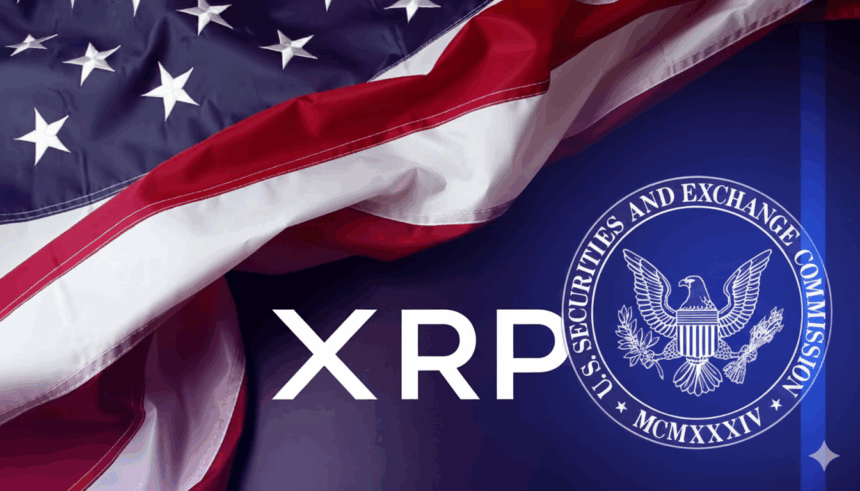In a legal saga that captivated the cryptocurrency world for nearly five years, the U.S. Securities and Exchange Commission (SEC) officially ended its landmark lawsuit against Ripple Labs in July 2025. This case, which began with a complaint filed in December 2020, alleged that Ripple’s sale of XRP tokens constituted a $1.3 billion unregistered securities offering [Source: SEC complaint, 2020]. The lawsuit’s conclusion with a $125 million settlement [Source: Reuters] brings a long-awaited resolution for Ripple, its investors, and the wider digital asset ecosystem.
The lawsuit was monumental because it went beyond a single company; it forced a high-stakes debate over whether cryptocurrencies, which often operate on decentralized ledgers, should be treated as traditional financial securities under U.S. law. The outcome has had far-reaching implications, influencing the trajectory of global crypto regulation, shaping institutional views on digital assets, and redefining investor confidence.
The Ripple vs. SEC Lawsuit Explained
What was the lawsuit about?
The Ripple vs. SEC lawsuit is one of the most significant legal battles in the history of cryptocurrency. On December 22, 2020, the U.S. Securities and Exchange Commission (SEC) filed a lawsuit against Ripple Labs, CEO Brad Garlinghouse, and co-founder Chris Larsen, alleging they conducted a $1.3 billion unregistered securities offering through the sale of XRP [Source: SEC complaint, 2020]. This case mattered because it wasn’t only about Ripple; it raised the broader question: Are cryptocurrencies like XRP securities under U.S. law? The outcome had potential consequences for the entire crypto industry, from Ethereum and Solana to exchanges like Coinbase and Binance.
How did the lawsuit impact XRP’s price in December 2020?
Immediately after the lawsuit became public, XRP’s price collapsed by nearly 60% within two days, falling from $0.55 to $0.21 [Source: CoinMarketCap historical data]. Several major exchanges, including Coinbase, Bitstamp, and OKCoin, suspended or delisted XRP trading by the end of December 2020 [Source: Reuters]. Liquidity dried up in the U.S., and trading volume plunged as investors scrambled to exit positions. This showed how regulatory action could directly influence cryptocurrency markets. XRP went from being the third-largest cryptocurrency by market cap in 2020 to sliding out of the top 10 within weeks.
How did exchanges react to the SEC lawsuit against Ripple?
Immediately after the lawsuit was filed in December 2020, U.S. exchanges suspended XRP trading to avoid compliance risks. Coinbase, Bitstamp, and OKCoin delisted XRP within weeks [Source: Reuters, Dec 2020]. Liquidity in U.S. markets collapsed, forcing many XRP traders to move to offshore exchanges. Grayscale Investments, the world’s largest digital asset manager, liquidated its XRP Trust in early 2021, citing regulatory uncertainty [Source: Bloomberg]. This response highlighted how much power the SEC’s classification could have. If XRP was deemed a security, every exchange offering it without an SEC license would be in violation of U.S. law.
What happened in 2021 during the court proceedings?
Throughout 2021, the case dragged on with heated debates over whether XRP should be classified as a security or a digital commodity. Ripple argued that, unlike an initial public offering (IPO), XRP was used as a utility token for cross-border payments. While the legal battle continued, XRP’s price showed remarkable resilience. In April 2021, during the broader crypto bull run led by Bitcoin hitting $64,000, XRP surged back above $1.80 [Source: TradingView XRP/USD chart]. This rebound demonstrated that market sentiment could outweigh legal uncertainty when broader conditions were bullish. However, U.S. traders remained cautious because of delistings, and XRP’s gains lagged behind coins like Ethereum (ETH), which hit new all-time highs above $4,800 later that year.
How did XRP holders and the community fight back?
Unlike many other crypto enforcement cases, XRP holders became active participants in the legal process. Over 75,000 XRP holders, represented by attorney John Deaton, filed motions to intervene in the case, arguing that the SEC’s actions unfairly harmed retail investors [Source: CryptoLaw]. The XRP community mobilized across social media and advocacy groups, presenting this case as not just about Ripple, but about the future of innovation in the United States. This grassroots element made the Ripple case unique compared to other SEC enforcement actions.
What was the key July 2023 court ruling?
On July 13, 2023, Judge Analisa Torres of the Southern District of New York issued a landmark ruling: Programmatic sales of XRP on exchanges did not constitute securities transactions. However, institutional sales of XRP to hedge funds and VCs were securities offerings [Source: Reuters]. This partial victory for Ripple caused XRP’s price to nearly double within 24 hours, spiking from $0.47 to $0.93 [Source: CoinMarketCap]. The ruling was celebrated across the crypto industry as a sign that tokens sold on secondary markets might avoid being labeled as securities.
The Final Outcome and Market Impact
After years of appeals and negotiations, Ripple reached a final settlement with the SEC in July 2025. According to reports from Bloomberg and Reuters, Ripple agreed to:
- Pay a $125 million civil penalty.
- Enhance compliance and disclosure practices.
- Settle without admitting or denying the allegations.
This brought regulatory clarity for XRP in the United States, although it left open the question of how other tokens would be treated.
How did XRP’s price react to the 2025 settlement?
In the days following the July 2025 settlement, XRP rose from $2.65 to $3.10, its highest level since 2018. As of August 28, 2025, XRP trades near $3.00, with a market cap around $165 billion [Source: CoinMarketCap live data]. This price is still below its all-time high of $3.84 in January 2018 but marks a strong recovery from the lows of $0.21 in 2020. XRP has outperformed many altcoins in 2025, driven by optimism around RippleNet adoption and the legal clarity gained from the settlement. Analysts on Investing.com and TradingView suggest XRP could test the $3.50 resistance zone if broader crypto sentiment remains bullish.
XRP Price Outlook: 2025-2030
As of August 28, 2025, XRP trades around $3.00 with a market capitalization of ~$165 billion, making it the 5th largest cryptocurrency behind Bitcoin, Ethereum, Tether, and BNB [Source: CoinMarketCap live data]. Since the Ripple–SEC settlement in July 2025, XRP has stabilized above $2.60 support and is now consolidating below $3.50 resistance, according to TradingView analysts [Source: TradingView XRP/USD chart]. This consolidation reflects post-settlement optimism, but also cautious positioning amid broader crypto market volatility.
What are short-term XRP price targets for 2025?
Analysts tracking XRP have highlighted several key technical levels:
- Upside targets: If XRP breaks $3.50 resistance, the next major zone lies near $4.00–$4.20, which would mark a new 7-year high [Source: Investing.com].
- Downside risks: A broader crypto sell-off could drive XRP down toward the $2.70–$2.50 range, where key technical support appears on the 50-day and 100-day moving averages [Source: Barchart.com].
Bloomberg Intelligence noted that “XRP remains tied to Bitcoin’s momentum,” meaning altcoins like XRP often outperform when Bitcoin stabilizes, but underperform when BTC retraces [Source: Bloomberg Crypto].
How do fundamentals support XRP beyond 2025?
Ripple’s business model and adoption play a large role in long-term XRP valuation. Key fundamentals include:
- Banking & Payments Partnerships: Ripple’s On-Demand Liquidity (ODL) product is used by institutions like Tranglo, SBI Remit, and Santander pilot projects. With the SEC case resolved, Ripple can now target U.S. banks again [Source: Reuters].
- Cross-Border Remittances: The World Bank estimates global remittances exceeded $860 billion in 2024. Ripple aims to capture a share of this by replacing SWIFT transfers with faster, cheaper XRP settlement.
- Regulatory Clarity: The settlement reduced uncertainty. XRP is unlikely to be delisted again in the U.S., opening the door for wider adoption on Coinbase, Kraken, and U.S. banks.
- Supply Dynamics: XRP’s total supply is 100 billion, with ~55 billion in circulation. Ripple still holds a large share in escrow but has pledged structured monthly releases. This makes XRP less inflationary than many new tokens [Source: CoinMarketCap].
What are XRP price predictions for 2026–2030?
2026 Outlook
- Bull Case: If Ripple secures U.S. banking adoption, XRP could test $5.00–$6.00.
- Bear Case: If regulatory challenges re-emerge (e.g., SEC pressures exchanges again), XRP could fall back toward $2.00–$2.20.
TradingView consensus estimates show XRP could average ~$4.50 in 2026 if Bitcoin enters a post-halving bull cycle.
2027–2028 Outlook
By 2027, EU’s MiCA framework and potential U.S. crypto laws could give XRP more legitimacy. Analysts at Investing.com note that if XRP captures just 5% of global remittances, its utility value could push it toward $8.00–$10.00 [Source: Investing.com]. However, Bloomberg warns that competition from stablecoins like USDC, USDT, and central bank digital currencies (CBDCs) may limit XRP’s upside. If adoption lags, XRP could instead stagnate between $3.00–$5.00 during this period.
2029–2030 Long-Term Outlook
By 2030, XRP’s valuation will depend on macro adoption trends:
- Bullish Scenario: If Ripple integrates with major central banks or SWIFT alternatives, XRP could reach $15.00–$20.00. This would imply a market cap rivaling Ethereum’s 2025 levels.
- Neutral Scenario: If adoption grows steadily but not exponentially, XRP could stabilize around $7.00–$10.00.
- Bearish Scenario: If regulatory headwinds return or CBDCs dominate cross-border payments, XRP may trade closer to $3.00–$4.00, barely above today’s levels.
Bloomberg analysts describe XRP as having “binary potential”: either it becomes a core payment infrastructure asset, or it risks being marginalized by state-backed solutions [Source: Bloomberg Crypto Outlook].
Key Risks for XRP Price Forecasts
- Regulatory Risks: Although Ripple settled with the SEC, new legislation could still impose restrictions.
- Competition from Stablecoins/CBDCs: Governments may prefer central bank digital currencies over private tokens.
- Liquidity Concentration: Ripple still controls a large portion of XRP, creating concerns of supply dumps.
- Bitcoin Correlation: As seen historically, XRP’s cycles depend on Bitcoin’s halving-driven market structure.
Global Regulatory Landscape & XRP’s Role
The SEC’s lawsuit against Ripple became a test case for digital asset regulation in the U.S. Unlike Bitcoin and Ethereum, which had informal regulatory clarity, XRP sat in a legal gray zone. The 2023 ruling and 2025 settlement helped establish that:
- Secondary market sales (on exchanges) are generally not securities.
- Institutional deals and pre-sales may still fall under securities law.
This precedent is now being applied in cases involving Coinbase, Binance, and other crypto issuers. Legal scholars from Harvard Law and financial regulators in the EU have cited the Ripple decision in ongoing debates about how to classify tokens.
How Did the Ripple Settlement Influence U.S. Crypto Policy?
The July 2025 Ripple–SEC settlement not only concluded one of the most significant crypto litigation cases but also influenced regulatory conversations across the United States. The SEC’s willingness to accept a $125 million fine without an admission of guilt offered a middle-ground template: enforcement paired with clarity rather than prolonged legal uncertainty [Source: Bloomberg Law, July 2025]. In Congress, lawmakers cited the Ripple outcome as proof that clear legislation is needed to distinguish securities from utility tokens. The bipartisan Lummis-Gillibrand Crypto-Currency Act gained renewed momentum in late 2025, partly spurred by the settlement’s example [Source: Reuters, August 2025].
What Is the Status of Crypto Regulation in Europe (MiCA) After Ripple?
Across the Atlantic, the European Union’s Markets in Crypto-Assets Regulation (MiCA) officially took effect in mid-2025. MiCA defines various token categories—including utility, asset-referenced, and e-money tokens—and requires issuers to register with regulators and comply with transparency requirements [Source: European Commission, MiCA text]. Ripple’s settlement narrative—a utility token defended successfully against securities classification—parallels MiCA’s approach. Many crypto firms have cited Ripple as a rationale for their own policies under MiCA, particularly regarding utility token issuance and disclosures.
How Are Asian and Emerging Markets Treating XRP and Ripple?
In Asia, where Ripple has longstanding ties, regulatory responses have been more welcoming. For example:
- Japan’s Financial Services Agency (FSA) regards XRP as a digital asset, not a security, and Ripple is registered as a Type II Crypto Asset Exchange Operator—allowing ODL and institutional partnerships to proceed [Source: FSA annual report, 2025].
- Singapore’s Monetary Authority (MAS) has approved RippleNet operations under its Payment Services Act, citing Ripple’s commitment to compliance and guidance from earlier regional clarifications.
Emerging markets in Africa and Latin America are exploring Ripple’s technology for remittance corridors. For example, Nigeria’s fintech firms have conducted pilot payment trials using XRP for interbank settlements, citing cost and speed advantages over SWIFT [Source: Reuters, 2025].
Why is XRP Now Seen as a Regulatory Bellwether?
XRP has become a reference point in legal and regulatory technology discussions for several reasons:
- Legal Precedent: The 2023 ruling and 2025 settlement provide a basis for how courts may treat token classifications going forward.
- Transparency Practices: Ripple’s disclosure of its escrow releases and institutional deals has set a standard for transparency among crypto firms.
- Global Outreach: Ripple’s partnerships with banks, service providers, and central banks in diverse markets, combined with the regulatory clarity from the settlement, position XRP as an example of compliance-driven innovation.
Regulatory Roadmap (2025–2030): What Comes Next?
Here’s a forecast of how Ripple and XRP could influence global regulation over the next five years:
| Timeframe | U.S. | Europe (EU & MiCA) | Asia & Emerging Markets |
| Mid 2025–2026 | Crypto bill under debate; Ripple cited frequently | MiCA implementation continues | RippleNet trials expand in Asia; stable legal grounds |
| 2026–2028 | Possible legislation codifying token definitions | Enforcement begins; industry adapts | CBDC pilots may integrate Ripple’s tech |
| 2028–2030 | Clear framework emerges; XRP accepted in institutional finance | MiCA expands scope; global companies align | Ripple-led remittance networks mature |
This table helps readers anticipate how XRP’s legal and regulatory trajectory may shape global governance and fintech systems.
Conclusion: XRP’s Journey and the Future of Crypto
The story of Ripple and XRP—from legal battles with the SEC to becoming a global regulatory bellwether—illustrates the maturing of the cryptocurrency market. What started as a fight over whether XRP should be classified as a security has evolved into a precedent-setting case that is shaping laws in the U.S., influencing MiCA in Europe, and providing a framework for regulators in Asia, Africa, and Latin America.
For investors, XRP’s resilience shows that regulatory clarity can unlock growth. The token’s ability to weather uncertainty, secure global partnerships, and maintain market relevance signals that XRP is no longer just another altcoin—it is a benchmark for how digital assets can integrate into traditional finance [Source: Reuters, Bloomberg].
For policymakers, Ripple’s case demonstrates that balanced regulation—rather than blanket enforcement—creates an environment where innovation thrives without undermining investor protection. Ripple has become a living case study for central banks, lawmakers, and institutions drafting crypto frameworks worldwide.
And for the crypto industry at large, XRP underscores a core truth: adoption follows clarity. Whether through cross-border payments, CBDC integrations, or institutional-grade remittance corridors, Ripple’s journey offers a playbook for how blockchain can deliver real-world impact.
Disclaimer: This blog post is for informational purposes only and does not constitute financial or investment advice. Cryptocurrency investments carry significant risks, and readers should conduct their own research before making decisions.









